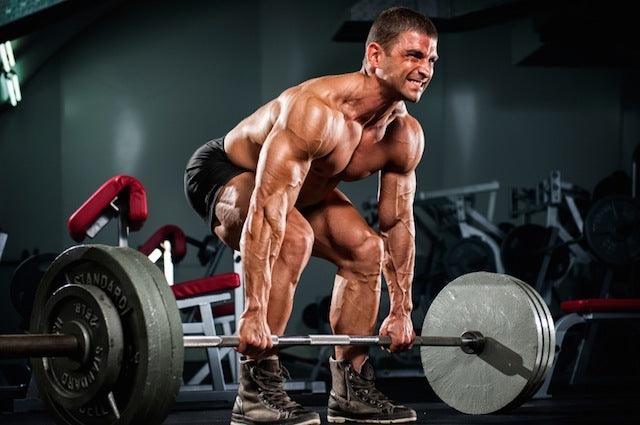

Shock Therapy for Muscle Growth
Table of Contents
| Shock Therapy for Muscle Growth |
by: Robbie Durand
Eccentric exercises are movements that lengthen or lowering the weight under tension, usually create an adaptation that improves performance. Previous studies have shown that if you just perform concentric exercises or lifting the weight, there is no muscle growth. Eccentric exercise is clearly an important factor for muscle growth and the research is becoming clear that eccentric exercise causes muscle growth thru activation of satellite cells. These unique cells are located on the outside of muscles, and they respond to damage in their vicinity by transforming into immature muscle fibers. More specifically, they move to the damaged area and fuse to muscle, becoming a part of it, creating muscle growth. Eccentric exercise training is nothing new back in the early 90’s there was a book called Bigger Muscles in 42 Days by Dr. Elliot Darden. The book took a revolutionary approach to training by advocated that people needed to spend less time in the gym but more importantly to emphasize eccentric contractions. Researchers have long been aware that maximal eccentric contractions result in more muscle damage and more muscle fiber growth, but researchers wanted to compare the differences between maximal concentric contractions and maximal eccentric contractions and how they affected satellite cells. Satellite cells are absolutely essential for muscle growth and repair, without the activation of satellite cells, muscle won’t grow.
 Optimal repair and adaptation of skeletal muscle is facilitated by resident stem cells (satellite cells). To understand how different exercise modes influence satellite cell dynamics, researchers measured satellite cell activity in conjunction with markers of muscle damage and inflammation in human skeletal muscle following a single work- and intensity-matched bout of eccentric or concentric contractions. Participants completed a single bout of eccentric or concentric of the knee extensors. A muscle biopsy was obtained before and 24 h after exercise. At the end of the study, peak power decreased following eccentric exercise but not concentric exercise. The researchers observed no significant changes in muscle soreness in the concentric group but they did observe significant increases in the eccentric group both immediately post-exercise and at 24-hours post- exercise. The researchers found that in the eccentric group, satellite cell content per muscle fiber increased significantly (by 27%) but there was no significant increase in the concentric group. They observed no differences in satellite cell content changes between muscle fiber types. In conclusion, eccentric but not concentric results in functional and histological evidence of muscle damage that is accompanied by increased satellite cell activity 24 h post-exercise. The research study should be a real wake up call for those athletes that want to grow, to emphasize eccentric contractions during their weight training by lowering the weight slowly with the heaviest weight possible. The result of increased muscle fiber size and the addition of the satellite cell’s to the muscle. The latter step is critical, because the nuclei in the muscle are primarily responsible for stimulating skeletal muscle protein synthesis and growth.
Optimal repair and adaptation of skeletal muscle is facilitated by resident stem cells (satellite cells). To understand how different exercise modes influence satellite cell dynamics, researchers measured satellite cell activity in conjunction with markers of muscle damage and inflammation in human skeletal muscle following a single work- and intensity-matched bout of eccentric or concentric contractions. Participants completed a single bout of eccentric or concentric of the knee extensors. A muscle biopsy was obtained before and 24 h after exercise. At the end of the study, peak power decreased following eccentric exercise but not concentric exercise. The researchers observed no significant changes in muscle soreness in the concentric group but they did observe significant increases in the eccentric group both immediately post-exercise and at 24-hours post- exercise. The researchers found that in the eccentric group, satellite cell content per muscle fiber increased significantly (by 27%) but there was no significant increase in the concentric group. They observed no differences in satellite cell content changes between muscle fiber types. In conclusion, eccentric but not concentric results in functional and histological evidence of muscle damage that is accompanied by increased satellite cell activity 24 h post-exercise. The research study should be a real wake up call for those athletes that want to grow, to emphasize eccentric contractions during their weight training by lowering the weight slowly with the heaviest weight possible. The result of increased muscle fiber size and the addition of the satellite cell’s to the muscle. The latter step is critical, because the nuclei in the muscle are primarily responsible for stimulating skeletal muscle protein synthesis and growth.

Whey Protein and Carbohydrates are like “Nitro” with Eccentric Training.
If your going to be incorporating eccentric exercise training, the amount of muscle damage you inflict on the muscle is going to rise dramatically. Your going to feel extremely sore after the workout due to the muscle damage inflicted locally to the muscle fibers, so its best to up your supplements for recuperation. Its best to incorporate eccentric exercise with a good carbohydrate and whey protein shake while doing this type of training. Here is the study that supports the importance of whey and carbohydrate supplementation. Researchers recruited twenty-four young healthy recreationally active men for a 12-week study with incorporating heavy eccentric exercise. Throughout the study period, the participants were instructed to maintain their normal habitual physical activity level and dietary intake. Three days prior to the start of the study, the participants were asked to refrain from physical exercise. One basal muscle biopsy was then sampled from a randomly chosen leg. The biopsy was repeated twice: Three days after the 7-day habituation phase, and 3-6 days after the last training session 12 weeks later. Each participant completed 2–3 exercise sessions per week over a 12-week period to a total of 33 training sessions. Eccentric load was aimed at 120 % relative to concentric loading, with a training supervisor assisting to allow isolated exercise modality of the two legs. The participants were instructed to perform the exercise with picture perfect form and at a tempo of 2 seconds on both the concentric and the eccentric phase of the exercise. Two minutes of recovery were interspaced between sets and all training sessions were closely supervised and monitored by qualified training instructors to ensure proper execution and loading. In addition, the effects of a whey protein hydrolysate +carbohydrate supplementation versus isocaloric carbohydrate supplementation were investigated in the single bout trial and the training period. The participants were randomly divided into one of the two supplement groups and supplements were provided in a double blinded fashion. Accordingly, the following four interventions were compared: (I) eccentric training with whey protein hydrolysate + carbohydrate ; (II) eccentric training with carbohydrate only; (III) concentric training with whey protein hydrolysate + carbohydrate , and; (IV) concentric training with carbohydrate. At the end of the study, twelve weeks of eccentric as well as concentric resistance training augmented hypertrophy with whey protein hydrolysate + carbohydrate group compared to the carbohydrate group, independently of exercise contraction type. In conclusion, maximal eccentric contraction mode may constitute a superior driver of acute anabolic signalling that may not be mirrored in the muscle protein synthesis rate. Furthermore, with prolonged high-volume resistance training, contraction mode seems less influential on the magnitude of muscle hypertrophy, whereas protein and carbohydrate supplementation augments muscle hypertrophy as compared to isocaloric carbohydrate supplementation. In sum, the study showed that the combination of whey protein and carbohydrate beverage had superior increases in muscle hypertrophy compared to the carbohydrate group while using eccentric exercise.
Aagaard, Per, et al. “Neural inhibition during maximal eccentric and concentric quadriceps contraction: effects of resistance training.” Journal of Applied Physiology 89.6 (2000): 2249-2257.
Rahbek et al. “Divergent resistance exercise contraction mode and dietary supplementation type on anabolic signalling.” Amino Acids (2014). Ahead of print.
Eliasson J, et al. Maximal lengthening contractions increase p70 S6 kinase phosphorylation in human skeletal muscle in the absence of nutritional supply. Am J Physiol Endocrinol Metab. 2006 Dec;291(6):E1197-205.
Rosenblatt JD, et al. Satellite cell activity is required for hypertrophy of overloaded adult rat muscle. Muscle Nerve. 1994 Jun;17(6):608-13.Rahbek et al. “Divergent resistance exercise contraction mode and dietary supplementation type on anabolic signalling.” Amino Acids (2014). Ahead of print.
Moore DR, Phillips SM, Babraj JA, Smith K, Rennie MJ. Myofibrillar and collagen protein synthesis in human skeletal muscle in young men after maximal
shortening and lengthening contractions. Am J Physiol Endocrinol Metab. 2005 Jun;288(6):E1153-9. Epub 2004 Nov 30.
Hyldahl RD, Olson T, Welling T, Groscost L, Parcell AC. Satellite cell activity is differentially affected by contraction mode in human muscle following a work-matched bout of exercise. Front Physiol. 2014 Dec 11;5:485.
MUSCLE MEDIA MAGAZINE FOR MEN
The premier source of training, nutrition, supplements, fat loss and health for men.

















